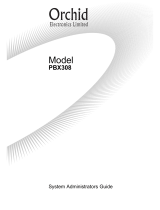
2.6.8 Utility—Error Log ............................................................................................................74
2.6.9 Utility—T1/E1 Signalling Bit Monitor
...............................................................................76
2.6.10 Utility—T1/E1 Line Trace ...............................................................................................77
2.6.11 Utility—ISDN/QSIG Protocol Trace ................................................................................78
2.6.12 Utility—V-IPGW16 Protocol Trace .................................................................................79
2.6.13 Utility—Digital Trunk Error Report ..................................................................................80
2.6.14 Utility—IP Extension Statistical Information ...................................................................81
2.6.15 Utility—CS Information ...................................................................................................82
2.6.16 Utility—PS Information ...................................................................................................83
2.6.17 Utility—CS Status Monitor ..............................................................................................84
2.6.18 Utility—Ping ....................................................................................................................85
2.6.19 Utility—File Transfer FTP to IP Equipment—IP-CS/NT400 ...........................................86
2.6.20 Utility—Card Software Timed Update ............................................................................87
2.6.21 Utility—System Reset—Reset by the Command ...........................................................88
2.7 Help ..................................................................................................................................89
2.7.1 Frequently Asked Questions (FAQ) ...............................................................................89
3 [1] Configuration ....................................................................................99
3.1 [1-1] Slot .........................................................................................................................100
3.2 [1-1] Slot—Summary .....................................................................................................103
3.3 [1-1] Slot—Activation Key ............................................................................................107
3.4 [1-1] Slot—Card Property - IPCMPR ............................................................................110
3.5 [1-1] Slot—OPB3 Card Property ..................................................................................130
3.6 [1-1] Slot—OPB3 Card Property—Card Command ....................................................134
3.7 [1-1] Slot—Port Property - Virtual IP Gateway Port ...................................................135
3.8 [1-1] Slot—Port Property - Virtual IP Gateway Port—Connection Command .........137
3.9 [1-1] Slot—Shelf Property - Virtual IP Gateway ..........................................................138
3.10 [1-1] Slot—Shelf Property - Virtual IP Gateway—GK Settings ..................................162
3.11 [1-1] Slot—Shelf Property - Virtual IP Gateway—GW Settings .................................163
3.12 [1-1] Slot—Shelf Property - Virtual IP Gateway—DN2IP ............................................170
3.13 [1-1] Slot—Shelf Property - Virtual IP Gateway—Hunt Pattern .................................172
3.14 [1-1] Slot—Card Property - Virtual IP Extension ........................................................173
3.15 [1-1] Slot—Port Property - Virtual IP Extension .........................................................180
3.16 [1-1] Slot—Port Property - Virtual IP Extension—Connection Command ...............189
3.17 [1-1] Slot—Card Property - Virtual SIP Extension ......................................................190
3.18 [1-1] Slot—Port Property - Virtual SIP Extension Port ...............................................194
3.19 [1-1] Slot—Port Property - Virtual SIP Extension Port—Connection
Command .......................................................................................................................199
3.20 [1-1] Slot—Card Property - Virtual IPCS .....................................................................200
3.21 [1-1] Slot—Port Property - Virtual IPCS ......................................................................207
3.22 [1-1] Slot—Port Property - Virtual IPCS—Connection Command ............................216
3.23 [1-1] Slot—Card Property - Extension Type ...............................................................217
3.24 [1-1] Slot—Port Property - Extension Port ..................................................................222
3.25 [1-1] Slot—Port Property - Extension Port—Connection Command ........................230
3.26 [1-1] Slot—Port Property - Extension Port—Port Type View ....................................231
3.27 [1-1] Slot—Card Property - LCO type ..........................................................................232
3.28 [1-1] Slot—Port Property - LCO Port ...........................................................................245
3.29 [1-1] Slot—Port Property - LCO Port—Connection Command .................................251
3.30 [1-1] Slot—Card Property - BRI type/PRI type ............................................................252
3.31 [1-1] Slot—Port Property - BRI Port .............................................................................267
3.32 [1-1] Slot—Port Property - BRI Port—Connection Command ...................................290
3.33 [1-1] Slot—Port Property - PRI Port .............................................................................291
3.34 [1-1] Slot—Port Property - PRI Port—Connection Command ...................................311
3.35 [1-1] Slot—Card Property - T1 type .............................................................................312
3.36 [1-1] Slot—Port Property - T1 Port ...............................................................................323
6 PC Programming Manual
Table of Contents




















